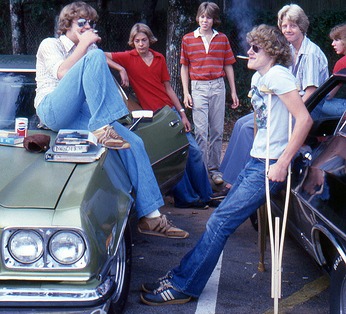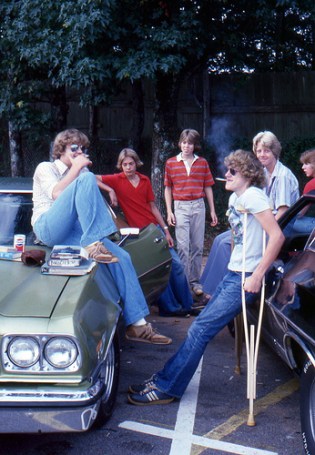To entice teenagers, Ford and other automakers need to make their cars more like smartphones … They could automatically check teenagers into Foursquare when they arrive at the mall. The car could read text messages aloud for the driver. It could have built-in cameras to take pictures and videos of passengers and upload them to Facebook and YouTube, also automatically tagging who is who in the images.
In Dazed and Confused, the classic ode to teenage freedom set in the mid-’70s, the majority of the action happens in or around cars; one character quips that she and her friends usually “just drive around” for fun.
I’ve always loved that film for how closely it approximates my own high school’s social world, thought it is set 30 years earlier. (I’m like the dorky redhead, except Matthew McConaughey never gave me his phone number.) But while the end-of-year hazing, kegs in parks, and frequent blazing it portrays rang as true in 2006 as 1976, the fact that cars are the, um, vehicles for all this rebellion already seemed a little vintage when I was in high school.
I could still fill up the tank for under $20 when I got my license, but burning gas to burn time was not an option for my allowance-and-summer-job budget or my millennial-generation conscience. I knew about the link between carbon emissions and global warming. Besides, I grew up in a city, and blasting “Slow Ride” doesn’t feel quite so badass when your ride is stopped in traffic.
Now that I’m out of school and working, I realize that the novelty of driving has worn off completely. I love road trips, but to me, driving in the city increasingly feels like more trouble than it’s worth. It only took a few months of living in Seattle without regular access to a car for me to adapt to the lifestyle, and although I’m now long-term borrowing a family car, my instinct — and often preference — is to eschew driving.
Instead, I find I get a certain sense of freedom from riding the bus. Taking the bus requires a different mindset; it requires you to let go of impatience, of the need for control. Relying on a bus schedule forces me to plan ahead and ensures that I’ll be on time, instead of dawdling until the last minute at home and then sweating through yellow lights. Once I get on the bus I can relinquish my control to the driver, relishing the passive travel time as an opportunity to collect myself on the way to work, make social plans on the way home, or just chill out and not worry about having to do anything until I get where I’m going.
Not relying on a car also means finding alternate, and often more interesting, routes to your destination; it allows you to experience your community on a different level. Walking, biking, or busing may sometimes be slower methods of transportation, but they add the kind of quality to your day that you just can’t get from a car, no matter how many built-in social networking features it comes with.
Another appeal of not driving is spending less time in isolation. We move to cities because we like to be close to each other; we like to know that there are other humans within easy reach. When I take the bus or walk, I feel much more engaged in the life of my city than when I’m stuck in a car. On public transportation, even if I’m listening to music or texting my friends, I’m part of a micro-community populated by the bus driver and passengers, united by the fact that, even if just for a few minutes, we’re all going the same direction at the same time.
Driving has the opposite effect: Everyone else on the road becomes a potential enemy who could rear-end you or steal your parking spot. A couple months ago, I found myself uncharacteristically driving on I-5 during Friday rush hour, and I was struck by how weird it felt to be alone in my little car, one unit inching along in a sea of other isolated units, all of us experiencing the same traffic from inside our individual bubbles. It’s a far cry from the freewheeling Dazed and Confused culture of driving as social activity.
Modern society’s preference for digital communication doesn’t mean we don’t still crave proximity. If anything, I think the growing appeal of technology is intertwined with that of urban living. Many more of us could work exclusively from home than do, but we still come into the office; maybe it’s because, as the New York Times recently reported, “research shows that physical proximity — as close as working in the same building — leads to increased knowledge, productivity, income, and employment.”
Why do people take their laptops to cafes? Okay, sometimes for the free wireless. But also, I think, because while we’re connecting virtually, we want to be reassured that we belong to a tangible universe. We still get lonely when we’re alone, even with the world at our fingertips.
Making cars more like smartphones would keep us seamlessly digitally connected, sure — but if we have the means to maintain that virtual connection almost constantly already, wouldn’t we rather take every opportunity we can to establish a physical presence in our immediate community? I would. It sure sounds less stressful and lonely than sitting behind the wheel of a car.
This isn’t the first time I’ve waxed poetic about the joys of public transport. I once wrote a story for my high school newspaper meditating on bus riding, to which a friend responded: “Taking the metro is like the raft in Huck Finn. You can be as fucked up or loud or smell-like-dog-piss or opinionated or personal or philosophical as you want to and no one can do anything about it.”
In other words, who needs a ’75 El Camino to have fun when you can be dazed and confused on the bus?



